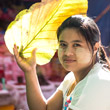Having been closed off to the world for decades, many of Myanmar’s pristine white sand beaches remain untouched. With this in mind, it is unsurprising that Myanmar is fast becoming one of South East Asia’s most sought-after beach destinations.
Ngapali
Unlike any other beach destination in the world, the working beach of Ngapali is renowned for its crystal clear waters and long stretch of idyllic palm lined, golden sandy coast. Whilst development is fast taking place, Ngapali is a long way off attracting similar tourists numbers to what you will find elsewhere in South East Asia. The area provides the perfect oasis in which to escape life’s complications, with a variety of first class accommodation and local restaurants serving up a range of sea to table culinary delights. Ngapali is also home to an unforgettable sunset, with many fisherman and local vendors choosing to walk the long sandy stretch on their way back home for dinner. Budding photographers will be pleased to know that this makes for some great photo opportunities.
Ngwe Saung
Those seeking an even more remote beach experience may wish to consider Ngwe Saung, Ngapali’s slightly more rustic, laid-back younger sister. A six-hour drive away by car from Yangon, logistically speaking it can be a bit tricky to incorporate, but those that make it will be treated to a local beach experience like no other. More popular with local tourists and expats looking to escape the hustle and bustle, Ngwe Saung boasts a semi-deserted white sand beach, affordable accommodation and grilled seafood restaurants, most of which can be found in the sleepy village centre. On the way to Ngwe Saung, it is also worth stopping off at Patein, Myanmar’s fourth largest city, and proud home of the iconic Burmese paper parasol.
Mergui (Myeik) Archipelago
If time, budget and availability permits, an adventure into the far reaches of Myanmar’s deep south comes highly recommended. Here you will find the Mergui (Myeik) Archipelago, a vast expanse of tropical ocean paradise, dotted with close to 800, mostly inhabited islands. Due to its remote nature and lack of comfortable accommodation, very few make it here, meaning those that do will be rewarded with one of the most exclusive beach experiences the world has to offer.
Just by looking at the names listed on the maritime chart, for example, Chelmsford Point and Charles Ross Hill, it is evident that little has changed here since the country’s days of colonial administration. This is also made clear from the vast number of deserted islands, most of which are covered in white sand, palm trees and dense patches of wild jungle. Now picture birds of prey flying overhead, the sound of playful gibbons echoing in the distance, and an abundance of rare and wonderful sea life just inches below the ocean’s surface. Then you have the shy Moken people, an Austronesian ethnic group with close to 3000 members that mostly lead a traditional, semi-nomadic lifestyle. Due to their shy nature and limited number, it is not often visitors will cross paths with one of the region’s inhabitants – in the case you are lucky enough to do so, it is likely they will be diving for sea cucumbers, fishing, or bartering away at one of the local island’s local pop-up markets.
For those looking to escape the stress of a busy lifestyle, look no further than a five to seven night break in one of the area’s resorts, or onboard the ship of one of the few boutique cruise operators. Relaxation opportunities here are ample, and due to a lack of network coverage, you are more likely to spend time reading through one of your favourite novels as opposed to keeping your work’s inbox up-to-date. It is not all relaxation however, as the more adventurous have the option of exploring tropical forests, hiking over valleys, kayaking through enchanted mangroves and diving beneath the surface of the beautiful, coral rich Andaman Sea.

